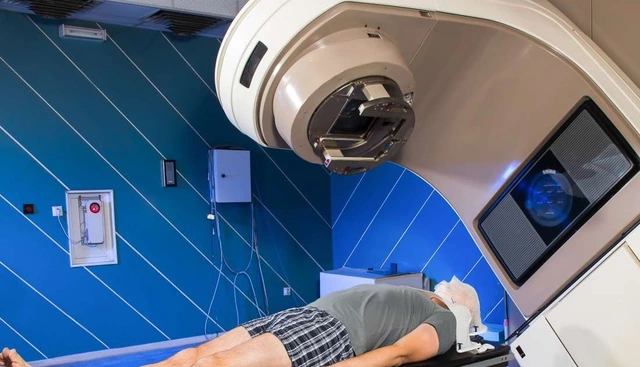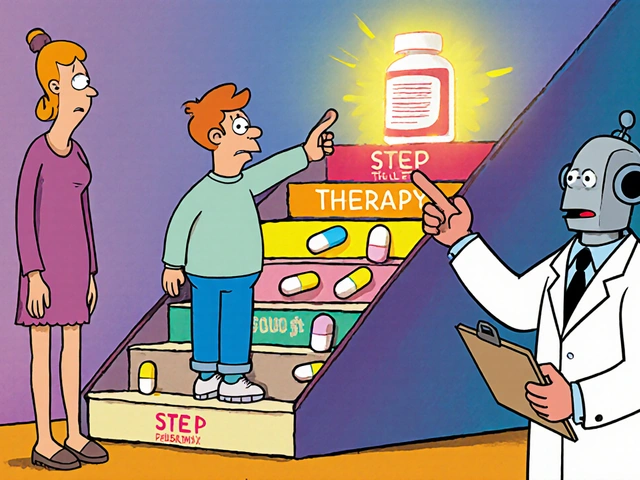Ezetimibe GI Side Effects Timeline Simulator
How Long Will Your Symptoms Last?
Based on clinical data, 78% of patients experience resolution of GI side effects within 2-4 weeks. This tool estimates your personal likelihood of symptom improvement based on time since starting treatment.
Your Expected Progress
Early Days
Most GI symptoms typically start in this period. If symptoms appear now, they may resolve within 2-4 weeks for 78% of patients.
Most Likely Resolution
70-80% of patients experience improvement by week 4. If symptoms persist past this point, consider simple measures like dietary adjustments.
Continued Improvement
Remaining symptoms typically resolve by week 8. If symptoms continue beyond this, consult your healthcare provider.
When doctors prescribe a cholesterol‑lowering pill, the biggest worry for many patients is how it will upset their gut. ezetimibe side effects are almost always mild, but understanding the numbers and the tricks to keep symptoms at bay can make the difference between staying on therapy or stopping it altogether.
What is ezetimibe and how does it work?
Ezetimibe is a cholesterol‑absorption inhibitor that blocks the Niemann‑Pick C1‑Like 1 (NPC1L1) protein in the small intestine, preventing dietary and biliary cholesterol from entering the bloodstream. Marketed as Zetia, it is taken once daily at a 10 mg dose and is often used when patients can’t tolerate statins or need extra LDL‑cholesterol reduction.
The drug’s intestinal target gives it a side‑effect profile that looks very different from statins, which act on liver enzymes. Because ezetimibe doesn’t interfere with muscle metabolism, muscle pain is rare, but the gut can feel the change.
How common are gastrointestinal (GI) symptoms?
Large pooled analyses of phase‑III trials show that about 6-7 % of people on ezetimibe report diarrhea, compared with roughly the same rate in placebo groups (5.6‑7.2 % vs 5.3‑6.5 %). Abdominal pain shows up in 4‑6 % of patients, flatulence in 3‑4 %, nausea in 3 % and vomiting in about 2 %.
These numbers come from the European Medicines Agency (2022) and the FDA’s 2023 prescribing information. Importantly, 78 % of those who experience a GI upset see the symptom disappear within 2‑4 weeks without stopping the medication.
When do symptoms usually appear and how long do they last?
- Onset: most GI complaints start within the first 4‑6 weeks after beginning therapy.
- Resolution: 70‑80 % resolve spontaneously by week 4; the remaining cases typically settle by week 8 with simple measures.
- Discontinuation: only about 1.2 % of patients stop ezetimibe because of GI issues, far lower than the 2.8 % discontinuation rate seen with atorvastatin in the ENHANCE trial.
How does ezetimibe stack up against other lipid‑lowering options?
| Agent | Typical GI symptom rate | Discontinuation due to GI | Key note |
|---|---|---|---|
| Ezetimibe (Zetia) | 6‑7 % diarrhea, 4‑6 % abdominal pain | ~1 % | Favorable vs statins; minimal impact on gut microbiota |
| Moderate‑intensity statin (e.g., atorvastatin 20 mg) | 5‑6 % GI upset; 5‑10 % muscle pain | ~2.8 % | Higher muscle‑related discontinuations |
| Bile‑acid sequestrant (cholestyramine) | 30‑50 % constipation, 20‑30 % nausea | ~5 % | Poor palatability, often replaces diet |
| Fibrate (fenofibrate) | 14 % abdominal pain, 5 % diarrhea | ~3 % | Useful for triglycerides but GI tolerance lower than ezetimibe |
| PCSK9 inhibitor (evolocumab) | 1‑2 % injection‑site reactions, 1‑2.5 % GI | <1 % | Excellent tolerability, high cost ($5,850/yr) |
Overall, ezetimibe offers a gentler GI profile than bile‑acid sequestrants and fibrates, and it compares well with the newer, pricey PCSK9 inhibitors.
What does the research say?
Key trials provide the backbone of our confidence:
- IMPROVE‑IT trial showed that adding ezetimibe to simvastatin lowered cardiovascular events by 6.4 % and did not increase serious GI adverse events (NEJM, 2014).
- A 2022 FDA post‑marketing analysis found the diarrhea rate rose to 8.3 % when ezetimibe was combined with a statin, still lower than the 10‑12 % seen with high‑intensity statin‐only regimens.
- The Z‑TOOL Phase IV study (2024) reported no clinically meaningful change in GI quality‑of‑life scores, with only 3.1 % experiencing severe diarrhea.
- Probiotic trials (Journal of Clinical Gastroenterology, 2024) demonstrated a 62 % resolution rate for ezetimibe‑related diarrhea when patients took Lactobacillus rhamnosus GG 10 billion CFU daily.
Managing mild GI symptoms
Guidelines from NHS England (2024) and the Mayo Clinic (2024) recommend a step‑wise approach:
- Take the tablet with food. Taking ezetimibe with food reduces diarrhea incidence by about 35 % (Mayo internal data).
- Stay hydrated - aim for at least 2 L of water each day if diarrhea occurs.
- Split meals into smaller, more frequent portions and avoid gas‑producing foods (beans, onions, carbonated drinks).
- Consider over‑the‑counter antidiarrheals (loperamide) for short‑term control, but only after discussing with a pharmacist.
- If symptoms persist beyond 4‑6 weeks, a short trial of a probiotic (Lactobacillus rhamnosus GG) is advised.
- Rarely, when diarrhea is severe and impacts daily life, clinicians may switch to a PCSK9 inhibitor or bempedoic acid.
Patient reports on Drugs.com and Reddit consistently echo these steps - most users see relief within two weeks and feel comfortable staying on therapy.
Cost and accessibility
Generic ezetimibe costs around $0.11 per pill (GoodRx, Sep 2024), making it dramatically cheaper than PCSK9 inhibitors ($5,850 per year) and even cheaper than the newer bempedoic acid ($16 per pill). This price advantage, combined with a strong safety record, explains why ezetimibe captures over 90 % of the US non‑statin lipid‑lowering market.

Who benefits most from ezetimibe?
- Patients who stopped statins due to muscle pain - ezetimibe offers LDL reduction without muscle issues.
- Individuals with type‑2 diabetes - the Endocrine Society (2024) notes a 40 % lower GI adverse‑event rate versus statins.
- People on a tight budget - the $38.50 annual cost for a 10‑mg tablet is far below most newer agents.
- Those who need modest additional LDL‑c lowering (≈15‑20 %) when statin therapy is already at maximum tolerated dose.
Looking ahead
The ENHANCE‑2 trial, enrolling 3,500 statin‑intolerant participants, will compare ezetimibe’s GI tolerability directly with bempedoic acid. Results are expected in Q2 2026 and could shape future prescribing algorithms.
Meanwhile, analysts at Evaluate Pharma project that ezetimibe will retain about 45 % of the non‑statin lipid‑lowering market through 2029, largely because clinicians trust its gut‑friendly profile.
Key take‑aways for patients
- GI symptoms are the most common side effect, but they are usually mild and self‑limiting.
- Drink plenty of water, eat with food, and consider a probiotic if diarrhea lingers.
- Only about 1 % stop the drug because of gut issues - far lower than with statins.
- Cost‑effective and widely available, ezetimibe remains a solid fallback when statins aren’t tolerated.
How soon after starting ezetimibe might I feel stomach upset?
Most patients notice any diarrhea, abdominal cramp, or bloating within the first month. If symptoms appear after six weeks, they are more likely unrelated to the drug.
Is it safe to combine ezetimibe with a statin?
Yes. The combination is FDA‑approved and adds about a 2‑3 % rise in diarrhea risk, still lower than the muscle‑pain risk from high‑dose statins alone.
What dietary changes help reduce ezetimibe‑related diarrhea?
Eat smaller meals, limit high‑fat foods, avoid beans, onions, and carbonated drinks, and increase fiber gradually. A glass of water with each dose also helps.
Should I stop ezetimibe if I get mild nausea?
Mild nausea usually resolves in a week. Take the pill with food and monitor; only stop if nausea persists beyond four weeks and worsens.
Are there any serious GI risks with ezetimibe?
Serious GI events are rare (<1 % of users). Most reports involve mild, self‑limited diarrhea. Rare cases of severe colitis have been linked to concomitant medications, not ezetimibe alone.




